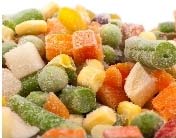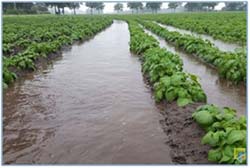Processors and farmers face severe losses in the major European growing areas for peas, carrots and other crops, the Brussels-headquartered European Association of Fruit and Vegetable Processing Industries (PROFEL) reported on July 8.
France, Belgium, the Netherlands, Germany, the UK and Denmark are heavily affected due to prolonged adverse weather conditions, including heavy rains and hail during late May, followed by more rain in June and into early July.
This year’s crop situation is the worst it has been in the last 40 years, according to PROFEL, with rainfall records for June broken in Belgium, the UK, France and the southeastern region of Holland.
 The consensus among frozen food packers and marketers visited and interviewed by editors of FrozenFoodsBiz.com traveling in Belgium, Holland and Germany during late June was that overall vegetable yields were likely to be approximately one-third less than last year’s harvest levels.
The consensus among frozen food packers and marketers visited and interviewed by editors of FrozenFoodsBiz.com traveling in Belgium, Holland and Germany during late June was that overall vegetable yields were likely to be approximately one-third less than last year’s harvest levels.
Two weeks later, growers and processors are unable to provide volume indications, as bad weather persists and field yields continue to decrease. For peas and carrots, it is clear that a significant part of the crop has already been lost. Spinach and cauliflower will also be in short supply.
The sowing of green beans has been dramatically delayed, with 80% of the seed that should already be in the ground at this time still waiting to be sown. Farmers and processors are doing their utmost to deal with expected volume losses, “but the situation looks very grim,” declared PROFEL in a statement.
The reason for this extraordinary delay in sowing is that farm equipment cannot maneuver or function properly on waterlogged fields, and because soil structure was compromised during the harvesting of early summer crops.
Aviko Analysis of Potato Situation
The cold and wet spring weather caused delayed planting of potatoes and therefore the late development of the early crop and main varieties. While increased temperatures during the last week of May allowed growth to catch up slightly, lower mid-June temperatures and heavy local rainfall did not support desired development, reported Jan Willem Peters of Aviko, the largest producer of value-added potato products in Holland.
 Despite this, the foliage of early varieties was good and with drier weather likely approaching, as well as some sunshine, the shift to the 2016 crop in the second half of July is still possible, said Peters.
Despite this, the foliage of early varieties was good and with drier weather likely approaching, as well as some sunshine, the shift to the 2016 crop in the second half of July is still possible, said Peters.
In May/June of each year, the first estimates of acreage under cultivation in Europe’s top five potato producing countries (the EU-5) are published by national statistic authorities. Based on available figures posted in late June, the 2016 EU-5 acreage will increase by almost 4% compared to last year, with the biggest expansion in Belgium, at around +10%. When this estimated acreage is multiplied with the 10-year average of EU-5 yields per hectare, the total production among the five countries amounts to 500,000 tons more than last year’s output.
“With the knowledge that the processing capacity in the EU-5 is expanding significantly, the increased acreage is not likely to lead to overproduction. It’s actually a necessary step to serve the growing global demand for potatoes,” stated Peters.





